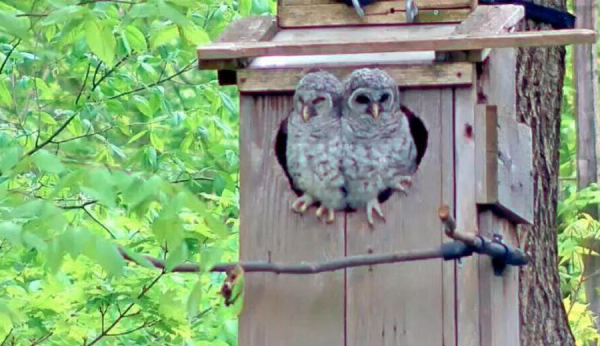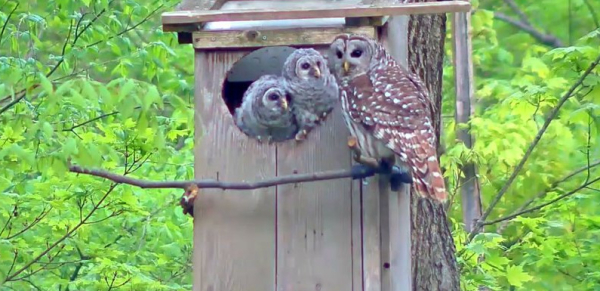
Two soon to fledge Barred Owl nestlings prepare to fledge after another successful big nest box season at Jim Carpenter’s infamous big backyard nest box.

An adult Barred Owl, probably the female, at the big nest box as the nestlings prepare to fledge. After leaving the nest, the adults continue to feed and protect the fledglings during the extended post-fledging period when they learn to fly and hunt for themselves.
|
The ultimate in patience may be required to experience the ultimate big nest box experience. If you added a big nest box to your yard recently, don’t be disappointed if it remains unused this spring. It may take a couple seasons to attract the interest of a cavity nesting species – perhaps a Wood Duck or Eastern or Western Screech Owls. But the ultimate patience can be credited to Jim Carpenter, the founder and CEO of Wild Birds Unlimited, who waited 8 years before his big nest box attracted a pair of nesting Barred Owls to his property – but he has had Barred Owls using the nest box most springs for almost 20 years since!
The accommodating pair of Barred Owls has become relatively famous, primarily because the nest box can be monitored via two live cameras – one inside the big nest box, and one mounted to show the action at the nest box from the outside.
We alerted you to the opportunity to monitor this nest back when the nestlings were just hatching, and we are happy to report that both nestlings successfully fledged about two weeks ago. Although the live camera viewing season inside and outside the big nest box is complete for this spring, there is now a remarkable 3-minute video that provides a nicely edited summary of video clips that takes you through the nesting season from start to finish, showing interactions between the nesting pair, unison calling, food exchanges, a hatching nestling, the female feeding the nestlings, the quick growth of the nestlings, and their eventual branching antics in advance of fledging. You get all the intimate details in just 3 minutes!
You will also enjoy reading some of the other information provided on the website, which is a shared effort by Wild Birds Unlimited and the Cornell Lab of Ornithology. We hope this example of how interesting and satisfying it can be to provide a nest box for cavity nesting birds – large or small, ranging from a House Wren to a Barred Owl – is well worth the effort, and it’s not too late to install a new nest box.
Even though many cavity nesting species are already nesting, it’s still worthwhile to construct or buy a new nest box or two for late-season re-nesting – and for future years. This is especially true for big nest boxes. With large nesting cavities and big nest boxes in short supply, it’s a worthy effort to add a big nest box or two to your property, or an abandoned farmstead or rural park – with permission of course. Larger cavity nesting species will benefit from such additions, including American Kestrels, Wood Ducks, and a variety of owls including Western and Eastern Screech Owls, Barn Owls, and Barred Owls. At the same time, when you place a small nest box in appropriate habitat, you can benefit bluebirds, Tree Swallows, Great Crested Flycatchers, or even a pair of Prothonotary Warblers if you’re in the right place.
For more information about the ultimate endeavor in patience and the resulting nesting successes of Barred Owls in an Indiana big nest box, see the Owl Cam Season Highlights video at https://www.wbu.com/owl-cam/
For a very interesting and informative look into the history behind Jim Carpenter’s Barred Owl nest box, see https://www.wbu.com/owl-box-history/
For more information about cavity nesting birds and providing appropriately sized nest boxes, please refer to the Cornell Lab’s NestWatch website, beginning at https://nestwatch.org/learn/all-about-birdhouses/birds/eastern-screech-owl/